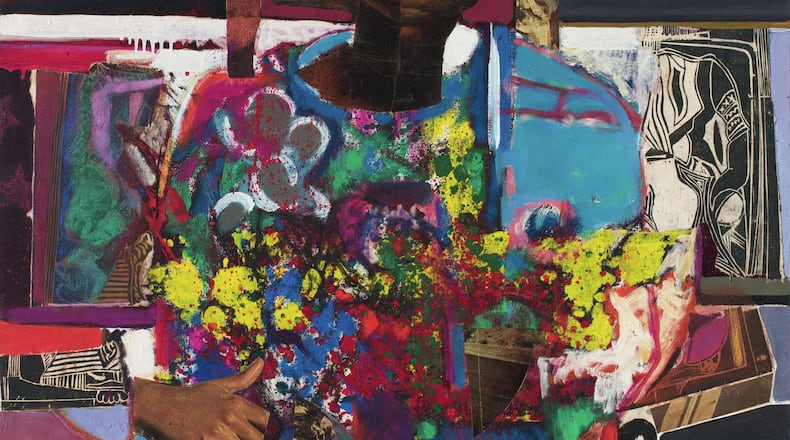Just as he would stir a pot of soup or stew, David Driskell would use similar gestures to mix oil paints before applying them to a canvas.
A deliberate rotation right or left, a long glance to appraise the precision of the blend. He was the most revered historian of Black art of his generation, if not the 20th century, but he was also an accomplished artist, equally adept at painting, collage and drawing images for his printmaking. A native of Eatonton, his curiosity also extended from his kitchen out to his vegetable gardens, and into his studio. Whether in a pot or on a palette, he didn’t stop adding and blending until the mixture felt or looked right.
“When he would paint in the studio, it was interesting to watch,” said Curlee Holton, director of the David C. Driskell Center at the University of Maryland and longtime friend of Driskell. “It appeared to be the same kind of gestures and the same kind of care for the paint and materials as he did when he was preparing food. With David, everything was very nuanced and full of value and interest.”
The arts community, particularly the Black arts community, mourned last year when Driskell died of complications from COVID-19 at age 88. He lived with his family in Hyattsville, Maryland.
In a career that spanned more than six decades, Driskell became the leading authority on the history of Black art in America and something of a king maker for younger Black artists who studied under him. He taught at historically Black colleges and universities including Fisk, Howard and Talladega before joining the faculty of the University of Maryland, College Park, where he continued to burnish his standing as a curator and author. The Clintons asked him to help choose artwork for the White House during their tenure. And he amassed an art collection so vast — it numbered at least 500 pieces almost 25 years ago — that a portion of it was the subject of a three-year national tour, “Narratives of African American Art and Identity: The David C. Driskell Collection,” from 1998 to 2001.
But Driskell was an accomplished artist in his own right, inspired by the Southern land of his birth and the experience of being a Black man in America. Two new exhibitions of his work open in Atlanta this month, which explore those themes. First, “David Driskell: Icons of Nature and History,” opens at the High Museum of Art on Feb. 6 and runs through May 9. The survey includes more than 60 of Driskell’s own drawings and paintings. From there the show is scheduled to travel to the Portland Museum of Art, in Maine — where Driskell once taught and where he maintained a summer home in Falmouth — and then to the Phillips Collection in Washington, D.C.
The second, eponymous show, “David Driskell,” opens on Feb. 16, at the September Gray Fine Art Gallery in Buckhead. While the show at the September Gray gallery is small and focuses on Driskell’s work in printmaking over the last 15 years, the High’s show spans much of the late artist’s career. From early drawings to his most recognizable pieces, including “Young Pines Growing” (on loan from the Clark Atlanta University Art Museum), to his masterwork, “Behold, Thy Son,” a meditation on the 1955 murder of Emmett Till, the show argues that Driskell created as fiercely for himself as he did the idea that Black art was essential to the American canon.
“As a scholar, it was important for him to ensure that there was a record of other Black artists because that’s how you trace your history,” said Julie McGee, a professor of Africana studies and art history at the University of Delaware, friend of Driskell and author of a book on his artistic life. “But this show is intended to really focus on his broad artistic career.”
Credit: Estate of David Driskell
Credit: Estate of David Driskell
“They chose him”
McGee is also a curator of “Icons of Nature and History.” Like Holton, she points to Driskell’s beginnings as the youngest of four children and the only boy in his family. They moved from Eatonton to North Carolina while he was young. His father farmed and was a blacksmith, but he was also a preacher. His mother was a prolific quilter. Those experiences deeply affected Driskell’s artistic vision, from images of pine trees to the use of color and collage technique.
Driskell’s formal path began at Howard University. Holton said Driskell often told the story of how he got into Howard. Not realizing he actually had to apply, Driskell simply showed up on campus and sat in on classes until he was found out. Rather than be kicked out, he was made to formally seek admission. There he came to the attention of James Porter, a professor and artist widely regarded as the nation’s first African American art historian. Porter encouraged him to pursue art history to further tell the story of Black artists. Porter himself had already published “Modern Negro Art,” the first true survey of Black art. But the influential artist and fellow Howard professor, Lois Mailou Jones, saw in Driskell an artist, one who could be successful despite segregation. Meanwhile, Holton said, Driskell sometimes served as a driver for Langston Hughes when he visited campus.
“They chose him,” Holton said of Driskell’s mentors. “He fit the model because he was graceful, well written and well spoken. He told me they even taught him how to pack his suitcase and how to prepare for travel. They did everything they could to get him ready and he took that charge and went for it.”
“Make art that speaks”
While art history was his focus throughout his teaching and writing careers at Talladega, Fisk and Howard, it was at HBCUs where Driskell did many of the works to be featured in the High’s show. “Young Pines Growing,” was completed while he was a professor at Talladega.
The pine tree had always been a presence in his life and was a recurring theme throughout his career.
“He found the pine tree as metaphor for his experience as a Black man,” said Michael Rooks, curator of modern and contemporary art at the High, which since 2005 has awarded the Driskell Prize to Black artists and art historians making a mark their fields.
Credit: Estate of David Driskell
Credit: Estate of David Driskell
Driskell graduated from Howard in 1955, the same year Emmett Till was murdered by white supremacists. Till’s mother’s decision to hold an open-casket funeral to show how badly her son’s body had been mutilated by his killers inspired Driskell’s painting, “Behold, Thy Son.” On view in the High show, it depicts a woman, likely Till’s mother, Mamie, cradling his body in the manner of a Pietà.
The mandate he followed and taught to his students was what he learned at HBCUs, McGee said: “Make art that speaks to contemporary circumstances.”
“Part of the Canon”
To show the nation how Black artists had always been part of the American artistic canon, while at Fisk Driskell conceived a show that cemented his reputation and career as an authority in his discipline. He somehow convinced trustees of the Los Angeles County Museum of Contemporary Art that American art and Black art were one and the same and curated the seminal exhibition, “Two Centuries of Black American Art: 1750-1950.” The traveling exhibition opened in 1976 in Los Angeles, and at the High in 1977.
Intended as a survey, the show featured more than 200 works by 63 artists, including Romare Bearden, Jacob Lawrence, Elizabeth Catlett and Henry O. Tanner, as well as accomplished but lesser known artists. It was an education for the masses. But for some critics, such as Hilton Kramer of The New York Times, the exhibition was something to sniff at. Kramer called it “mediocre” and, in many instances, and unfocused.
Driskell was undaunted and launched a full-throated defense of the exhibition in national media. By then, secure as a curator and author, he was assured in his vision, Holton said.
“David could determine whether you were part of the canon or not,” Holton said. “If he didn’t write about you, your work wasn’t worthy. (Museum curators) would come to him and say, ‘What is this worth, David? Is this really a Henry O. Tanner?’ He was an expert.”
Credit: Estate of David Driskell
Credit: Estate of David Driskell
He eventually moved to the University of Maryland in the late 1970s where he continued to write and curate, but also create. His studios in Maryland and at his summer home in Maine (he’d done a stint teaching at Bowdoin College) were filled with scraps of paper, magazine clippings, trinkets and tubes of paint.
“Anyone who would visit his studio found he threw nothing away,” McGee said. “He would tear up proofs of prints he did and use them in a collage, so you might find the delight of a fragment from one of them in another piece.”
Those surprises await viewers at both Atlanta shows, which in many ways are testaments to the artist’s rituals.
“Whether it was making food, whether it was growing vegetables, tending to his garden or making art, it was all very tactile, in some ways kind of magical,” Holton said.
Credit: Estate of David Driskell
Credit: Estate of David Driskell
EVENT PREVIEW
“David Driskell: Icons of Nature and History”
Masks required for entry. 10 a.m.-5 p.m. Monday-Saturday; noon-5 p.m. Sunday. $14. High Museum of Art, 1280 Peachtree St. NE, Atlanta. 404-733-4400, high.org.
d
Masks required for entry. To observe social distancing, appointments are required during the following hours of operation: 11 a.m.-5:30 p.m. Wednesday-Friday; 11 a.m.-4:30 p.m. Saturday; appointment only Tuesday; closed Monday. Free. September Gray Fine Art Gallery, 75 Bennett St., Suite O-2, Atlanta. 404-907-1923, septembergrayart.com.
Accomplishments of David Driskell
- He taught at historically Black colleges and universities including Fisk, Howard and Talladega as well as University of Maryland.
- The Clintons asked him to help choose artwork for the White House during their tenure.
- He amassed an art collection of at least 500 pieces that was the subject of a three-year national tour from 1998-2001.
About the Author
The Latest
Featured






